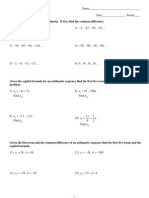Fibonacci Sequence
Uploaded by
Manuel FierroFibonacci Sequence
Uploaded by
Manuel FierroFibonacci Sequence
The Fibonacci Sequence is the series of numbers: 0, 1, 1, 2, 3, 5, 8, 13, 21, 34, ... The next number is found by adding up the two numbers before it.
The 2 is found by adding the two numbers before it (1+1) Similarly, the 3 is found by adding the two numbers before it (1+2), And the 5 is (2+3), and so on!
Example: the next number in the sequence above would be 21+34 = 55 It is that simple! Here is a longer list: 0, 1, 1, 2, 3, 5, 8, 13, 21, 34, 55, 89, 144, 233, 377, 610, 987, 1597, 2584, 4181, 6765, 10946, 17711, 28657, 46368, 75025, 121393, 196418, 317811, ... Can you figure out the next few numbers?
Makes A Spiral
When you make squares with those widths, you get a nice spiral:
Do you see how the squares fit neatly together? For example 5 and 8 make 13, 8 and 13 make 21, and so on.
The Rule
The Fibonacci Sequence can be written as a "Rule" (see Sequences and Series). First, the terms are numbered from 0 onwards like this: n= xn = 0 0 1 1 2 1 3 2 4 3 5 5 6 8 7 13 8 21 9 34 10 55 11 12 13 14 ... 89 144 233 377 ...
So term number 6 is called x6 (which equals 8).
Example: the 8th term is the 7th term plus the 6th term:
x8 = x7 + x6
So we can write the rule: The Rule is xn = xn-1 + xn-2 where:
xn is term number "n" xn-1 is the previous term (n-1) xn-2 is the term before that (n-2)
Example: term 9 would be calculated like this: x9 = x9-1 + x9-2 = x8 + x7 = 21 + 13 = 34
Golden Ratio
And here is a surprise. If you take any two successive (one after the other) Fibonacci Numbers, their ratio is very close to the Golden Ratio "" which is approximately 1.618034... In fact, the bigger the pair of Fibonacci Numbers, the closer the approximation. Let us try a few: A 2 3 5 8 ... 144 233 ... B 3 5 8 13 ... 233 377 ... B/A 1.5 1.666666666... 1.6 1.625 ... 1.618055556... 1.618025751... ...
Note: this also works if you pick two random whole numbers to begin the sequence, such as 192 and 16 (you would get the sequence 192, 16, 208, 224, 432, 656, 1088, 1744, 2832, 4576, 7408, 11984, 19392, 31376, ...): A B 192 16 16 208 208 224 224 432 ... ... 7408 11984 11984 19392 ... ... B/A 0.08333333... 13 1.07692308... 1.92857143... ... 1.61771058... 1.61815754... ...
It takes longer to get good values, but it shows you that it is not just the Fibonacci Sequence that can do this!
Using The Golden Ratio to Calculate Fibonacci Numbers
And even more surprising is that we can calculate any Fibonacci Number using the Golden Ratio:
The answer always comes out as a whole number, exactly equal to the addition of the previous two terms. Example:
When I used a calculator on this (only entering the Golden Ratio to 6 decimal places) I got the answer 8.00000033. A more accurate calculation would be closer to 8. Try it for yourself!
A Pattern
Here is the Fibonacci sequence again: n= xn = 0 0 1 1 2 1 3 2 4 3 5 5 6 8 7 8 9 10 11 12 13 14 15 ... 13 21 34 55 89 144 233 377 610 ...
There is an interesting pattern:
Look at the number x3 = 2. Every 3rd number is a multiple of 2 (2, 8, 34, 144, 610, ...) Look at the number x4 = 3. Every 4th number is a multiple of 3 (3, 21, 144, ...) Look at the number x5 = 5. Every 5th number is a multiple of 5 (5, 55, 610, ...)
And so on (every nth number is a multiple of xn).
Terms Below Zero
The sequence can be extended backwards! Like this: n= xn = ... ... -6 -8 -5 5 -4 -3 -3 2 -2 -1 -1 1 0 0 1 1 2 1 3 2 4 3 5 5 6 8 ... ...
(Prove to yourself that adding the previous two terms together still works!) In fact the sequence below zero has the same numbers as the sequence above zero, except they follow a +-+- ... pattern. It can be written like this:
xn = (1)n+1 xn Which says that term "-n" is equal to (1)n+1 times term "n", and the value (1)n+1 neatly makes the correct 1,-1,1,-1,... pattern.
History
Fibonacci was not the first to know about the sequence, it was known in India hundreds of years before!
About Fibonacci The Man
His real name was Leonardo Pisano Bogollo, and he lived between 1170 and 1250 in Italy. "Fibonacci" was his nickname, which roughly means "Son of Bonacci". As well as being famous for the Fibonacci Sequence, he helped spread through Europe the use of Hindu-Arabic Numerals (like our present number system 0,1,2,3,4,5,6,7,8,9) to replace Roman Numerals (I, II, III, IV, V, etc). That has saved us all a lot of trouble! Thank you Leonardo.
You might also like
- Pagkamaka-Bayan: The Good Citizenship Value of UnityNo ratings yetPagkamaka-Bayan: The Good Citizenship Value of Unity11 pages
- Luenberger - Optimzation by Vector Space MethodsNo ratings yetLuenberger - Optimzation by Vector Space Methods341 pages
- A Course Module For: Mathematics in The Modern World0% (1)A Course Module For: Mathematics in The Modern World21 pages
- Positive and Negative Filipino Cultural ValuesNo ratings yetPositive and Negative Filipino Cultural Values4 pages
- Chapter 1: Nature of Mathematics: Section 1.1 Patterns and Numbers in Nature and The WorldNo ratings yetChapter 1: Nature of Mathematics: Section 1.1 Patterns and Numbers in Nature and The World26 pages
- Unit 1 The Self From Various Perspective: SuccessNo ratings yetUnit 1 The Self From Various Perspective: Success12 pages
- UST (1) - Apalis - Trisha - Ann - Morales - BSN1GNo ratings yetUST (1) - Apalis - Trisha - Ann - Morales - BSN1G3 pages
- Ancient Chinese Mathematics (A Very Short Summary)No ratings yetAncient Chinese Mathematics (A Very Short Summary)7 pages
- Decoding The Secrets Patterns in Nature Reflection PaperNo ratings yetDecoding The Secrets Patterns in Nature Reflection Paper1 page
- Module 1: The Nature of Mathematics: Lesson 1.3 The Fibonacci SequenceNo ratings yetModule 1: The Nature of Mathematics: Lesson 1.3 The Fibonacci Sequence15 pages
- MODULE 2 (Lesson 3) - PSYCHOMOTOR DOMAINNo ratings yetMODULE 2 (Lesson 3) - PSYCHOMOTOR DOMAIN12 pages
- A Reaction Paper On Nature's Numbers: The Unreal Reality of MathematicsNo ratings yetA Reaction Paper On Nature's Numbers: The Unreal Reality of Mathematics3 pages
- Learning Task 3.1 Before The Scientific RevolutionNo ratings yetLearning Task 3.1 Before The Scientific Revolution1 page
- Lesson 8 Musical Content On Rythmn and TempoNo ratings yetLesson 8 Musical Content On Rythmn and Tempo26 pages
- Laboratory Activity 5 - Soil Texture ExperimentNo ratings yetLaboratory Activity 5 - Soil Texture Experiment2 pages
- Lesson Reparation/ Review/Preview: Intended Learning OutcomesNo ratings yetLesson Reparation/ Review/Preview: Intended Learning Outcomes21 pages
- Module 1 Assignment - Contextualization of History-2No ratings yetModule 1 Assignment - Contextualization of History-22 pages
- Measures of Central Tendency: Mean Median Mode Weighted Mean100% (2)Measures of Central Tendency: Mean Median Mode Weighted Mean20 pages
- GEC-Reflection Sigmund Freud Reflection PaperNo ratings yetGEC-Reflection Sigmund Freud Reflection Paper2 pages
- Get Discrete Mathematics and Applications 2nd Edition Ferland Free All Chapters100% (8)Get Discrete Mathematics and Applications 2nd Edition Ferland Free All Chapters62 pages
- Greetings From Globussoft: Search Engine Like Google, Yahoo, BingNo ratings yetGreetings From Globussoft: Search Engine Like Google, Yahoo, Bing7 pages
- Department of Education: M10AL-Ia-1 M10AL-Ia-1No ratings yetDepartment of Education: M10AL-Ia-1 M10AL-Ia-18 pages
- Loosely-Coupled Processes: 1.1 Message Communicating and Shared-Variable SystemsNo ratings yetLoosely-Coupled Processes: 1.1 Message Communicating and Shared-Variable Systems19 pages
- Sequences of Functions Pointwise and Uniform Convergence: Math 401 - NotesNo ratings yetSequences of Functions Pointwise and Uniform Convergence: Math 401 - Notes5 pages
- IT4L2 Java Lab Credits:2 Internal Assessment: 25 Marks Lab: 3 Periods/week Semester End Examination: 50 Marks ObjectivesNo ratings yetIT4L2 Java Lab Credits:2 Internal Assessment: 25 Marks Lab: 3 Periods/week Semester End Examination: 50 Marks Objectives2 pages
- Journal: Caronan, Chelclairish Gresha DL. 10 - Argon Submitted To: Ma'am Farah MadisonNo ratings yetJournal: Caronan, Chelclairish Gresha DL. 10 - Argon Submitted To: Ma'am Farah Madison5 pages
- Izho 2018 Experiment (Problems & Solutions)No ratings yetIzho 2018 Experiment (Problems & Solutions)11 pages
- Programa Analitica Materii Cibernetica in EnglezaNo ratings yetPrograma Analitica Materii Cibernetica in Engleza7 pages
- Pagkamaka-Bayan: The Good Citizenship Value of UnityPagkamaka-Bayan: The Good Citizenship Value of Unity
- A Course Module For: Mathematics in The Modern WorldA Course Module For: Mathematics in The Modern World
- Chapter 1: Nature of Mathematics: Section 1.1 Patterns and Numbers in Nature and The WorldChapter 1: Nature of Mathematics: Section 1.1 Patterns and Numbers in Nature and The World
- Ancient Chinese Mathematics (A Very Short Summary)Ancient Chinese Mathematics (A Very Short Summary)
- Decoding The Secrets Patterns in Nature Reflection PaperDecoding The Secrets Patterns in Nature Reflection Paper
- Module 1: The Nature of Mathematics: Lesson 1.3 The Fibonacci SequenceModule 1: The Nature of Mathematics: Lesson 1.3 The Fibonacci Sequence
- A Reaction Paper On Nature's Numbers: The Unreal Reality of MathematicsA Reaction Paper On Nature's Numbers: The Unreal Reality of Mathematics
- Learning Task 3.1 Before The Scientific RevolutionLearning Task 3.1 Before The Scientific Revolution
- Lesson Reparation/ Review/Preview: Intended Learning OutcomesLesson Reparation/ Review/Preview: Intended Learning Outcomes
- Module 1 Assignment - Contextualization of History-2Module 1 Assignment - Contextualization of History-2
- Measures of Central Tendency: Mean Median Mode Weighted MeanMeasures of Central Tendency: Mean Median Mode Weighted Mean
- Get Discrete Mathematics and Applications 2nd Edition Ferland Free All ChaptersGet Discrete Mathematics and Applications 2nd Edition Ferland Free All Chapters
- Greetings From Globussoft: Search Engine Like Google, Yahoo, BingGreetings From Globussoft: Search Engine Like Google, Yahoo, Bing
- Loosely-Coupled Processes: 1.1 Message Communicating and Shared-Variable SystemsLoosely-Coupled Processes: 1.1 Message Communicating and Shared-Variable Systems
- Sequences of Functions Pointwise and Uniform Convergence: Math 401 - NotesSequences of Functions Pointwise and Uniform Convergence: Math 401 - Notes
- IT4L2 Java Lab Credits:2 Internal Assessment: 25 Marks Lab: 3 Periods/week Semester End Examination: 50 Marks ObjectivesIT4L2 Java Lab Credits:2 Internal Assessment: 25 Marks Lab: 3 Periods/week Semester End Examination: 50 Marks Objectives
- Journal: Caronan, Chelclairish Gresha DL. 10 - Argon Submitted To: Ma'am Farah MadisonJournal: Caronan, Chelclairish Gresha DL. 10 - Argon Submitted To: Ma'am Farah Madison





























































































